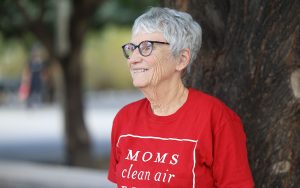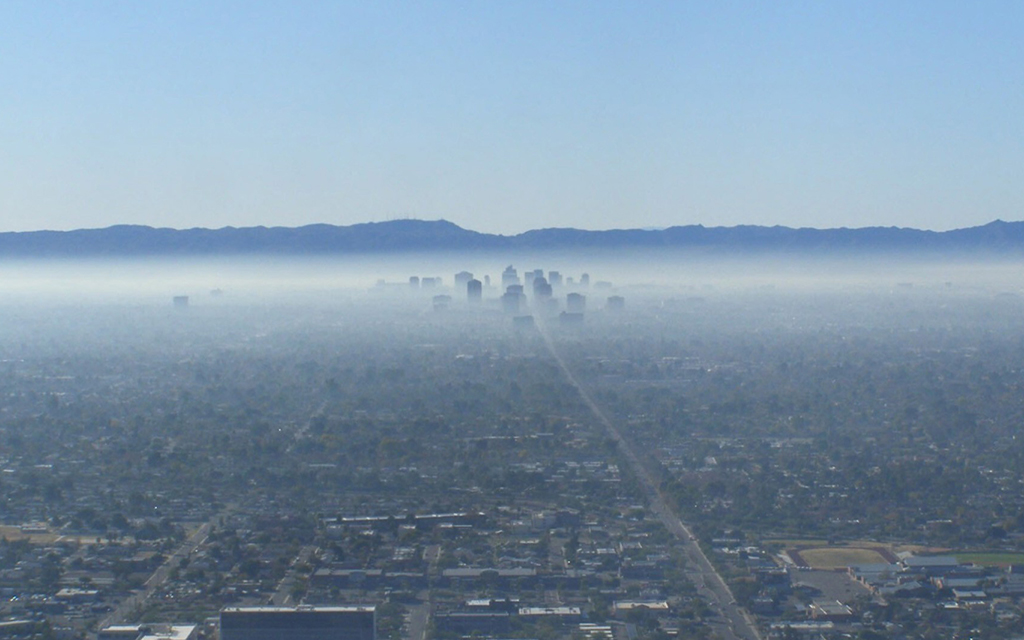PHOENIX – On Aug. 30, the Sierra Club’s Grand Canyon Chapter issued a 2023 environmental report card that cited the American Lung Association’s report ranking Phoenix air the seventh worst city in the country for particle pollution and fifth worst for ozone level. This poor air quality has led to an increase in health concerns, particularly for marginalized communities.
According to the American Lung Association’s 2023 State of the Air report, four counties in Arizona earned an F grade on their air quality: Gila, Maricopa, Pima and Pinal.
Maricopa County currently has just over 2 million people who identify as nonwhite. According to a 2022 report conducted by the Arizona Department of Health Services, 23% of adults identifying as Black/African American have been diagnosed with asthma, contrasted with the 16% of white non-Hispanic adults who have asthma.
JoAnna Strother, senior director of advocacy for the American Lung Association in Arizona, said that “our communities of color are disproportionately exposed to unhealthy air, and people of color are also most likely to live with one or more chronic conditions that make them more vulnerable to the health impacts of air pollution. This includes asthma, diabetes and heart disease.”
A 2019 Centers for Disease Control and Prevention report showed that Black people are five times more likely than white people to be hospitalized for asthma-related instances across the U.S.
“A higher rate of people of color and other disadvantaged groups live near high pollution sources,” Strother said. These sources of exposure include but aren’t limited to highways, warehouses, power plants and heavily populated rural areas.
Hazel Chandler, a field organizer for the Arizona environmental group Moms Clean Air Force, has been diagnosed with asthma and living with cancer for the past 11 years. Last summer, Chandler said she suffered from an unrelenting coughing episode, which she said was caused by high ozone levels and poor air quality, that progressed for four months.

Hazel Chandler, a field organizer for the Arizona environmental group Moms Clean Air Force, has been diagnosed with asthma and living with cancer for the past 11 years. (Photo by Sam Volante/Cronkite News)
Chandler said the intense coughing caused 12 hairline fractures in her spine and forced her to go into emergency surgery. This incident, along with other medical expenses, contributed to overwhelming medical costs.
“All of us that are living with the effects of air pollution have tremendous medical bills,” Chandler said.
Strother emphasized that the transportation sector is one of the largest sources of pollution. If Arizona switches to electric vehicles by 2050, the American Lung Association believes that 38,500 asthma attacks would be prevented and 1,360 lives would be saved.
As detailed in the Sierra Club’s report, this past session of the Arizona Legislature worked on several bills that would impact the environment, some of which dealt with public and electric transportation.
One of these bills was SB 1102, which was rushed through on the final day of the legislative session. The additions to the bill included restrictions to the expansion of the public light rail system, killing a proposed rail line extension that would have gone to the Capitol.
The bill also included air quality additions defined as “paving unpaved roads and procuring street sweepers to meet the requirements of the Clean Air Act.” Current guidelines from the Environmental Protection Agency require ozone levels to be under 70 ppb (parts per billion).
“We did have a win,” said state Rep. Nancy Gutierrez, D-Tucson, as she talked about this year’s budget. “There is money for electric vehicle expansion; that is definitely where the future is headed for us, along with other clean energy standards.”
But the Legislature also adopted a resolution noting that during the 2020 COVID-19 pandemic “ozone levels increased from 79ppb to 87ppb despite the fact that most vehicular and business activity was halted in Maricopa County.” It called on President Biden and Congress to keep the EPA from imposing fines on Arizona and from enforcing a lower clean-air standard – 70 ppb – that is likely “impossible to attain through any of the control measures being considered.”
Organizations such as the Sierra Club consistently advocate to do more for the environment. Sandy Bahr, the director of the Sierra Club’s Grand Canyon chapter, criticized the past Arizona legislative session, saying there was “no action on climate.”
Arizona Sen. John Kavanagh, R-Fountain Hills, rebutted Bahr’s statement.“The Sierra Club has to understand it’s not all about the environment, you have to consider other people’s needs and wants and their ability to pay,” he said.
The report by the Sierra Club grades individual politicians for their votes on bills that would impact the environment. Most Republicans in office earned an F grade, while grades for Democrats varied across the board. Gov. Katie Hobbs secured an A.
Arizona Sen. Juan Mendez, D-Tempe, a member of the Senate Natural Resources, Energy and Water Committee, earned an A on this report card and agrees with Bahr’s assessment. “There’s lots of areas to improve. I almost feel like we did nothing for the environment,” he said.
In the next legislative session, Mendez hopes to pass multiple bills that positively affect the environment and said that he’s already begun brainstorming for the upcoming year.




